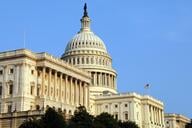You have /5 articles left.
Sign up for a free account or log in.
The federal budget deal announced by Congressional negotiators Tuesday evening would largely alleviate cuts to research funding and campus-based student aid programs.
The agreement, reached by Representative Paul Ryan, a Republican, and Senator Patty Murray, a Democrat, would fund the government for the remainder of the current fiscal year at a level higher than a House-passed budget proposal but lower than the level that the Senate and President Obama had sought. The deal also sets the top-line funding level for the 2015 fiscal year that begins next October, a provision that negotiators said they hoped would restore more certainty and order to the federal budget process.
The proposal does not lay out specific amounts of money for federal agencies but it would increase, from its current level, the overall pool of money available in the part of the budget that affects higher education and research.
If the deal were to be approved, Congressional appropriators would have at their discretion $492 billion for non-military spending. That’s about $23 billion more than would be available if Congress were to allow a second round of automatic cuts to take effect in January. But it’s still about $14 billion below the original level of non-defense funding before the cuts first took place in March.
Within the confines of those top-level limits, lawmakers would have the discretion to restore (and theoretically increase) funding to campus-based financial aid programs and federal research agencies such as the National Institutes of Health and National Science Foundation, which would otherwise suffer more cuts if a second round of mandated "sequestration" reductions take place in January.
“The higher [budget] caps for both years should allow the restoration of some damaging cuts, and should at the minimum prevent any further cuts for the next two years,” said Jon Fansmith, director of government relations at the American Council on Education.
Ryan and Murray will still have to sell the deal to their respective caucuses. Both President Obama and House Speaker John Boehner on Tuesday praised the compromise, though some conservative lawmakers and action groups said they were opposed to the deal.
Congress needs to pass new spending bill before January 15 to avert another government shutdown.
Advocates for higher education and researching funding offered tepid praise for the deal, noting that although it would not completely reverse the effects of the sequestration cuts imposed so far, it was a good step forward.
Peter McPherson, the president of the Association of Public and Land-grant Universities, called the agreement “imperfect” but said it nonetheless “warrants the support of lawmakers.”
“The budget agreement announced tonight demonstrates just how unpopular sequestration has become with members of both parties and the American people,” McPherson said in a statement. “This deal is an important first step toward ending the reckless and blunt cuts brought upon by the sequester that have unnecessarily inflicted pain across the country, including in research labs at public universities.”
The deal would allow a restoration in the current fiscal year of about 87 percent of the amount that the March 2013 sequester cut out of all non-defense spending that is under the discretion of Congress, according to Joel Packer, executive director of the Committee for Education Funding, an umbrella lobbying coalition of education groups.
“We are generally pleased,” Packer said. “While not what we ideally hoped for, which was a complete replacement of the entire sequester for the remaining eight years, this deal does stop the cuts.”
The deal, he added, provides a “funding level that stops moving investments in education backward but instead turns the corner so we can start catching up to where we were.”
Cuts for Loan Servicers
The agreement reached Wednesday calls for Congress to reverse some sequestration cuts without raising taxes or making changes to entitlement programs. In order to pay for the $63 billion worth of increases to federal discretionary spending over the next two years, negotiators identified various sources of revenue, such as hiking airline security fees and requiring federal workers to kick in more money for their pension plan.
In addition, the agreement calls for Congress to cut payments to guarantee agencies in the now-defunct Federal Family Educational Loan Program, and changes how certain federal student loan servicers are paid.
“End the special treatment for non-profit student-loan servicers,” Ryan, the House Budget Committee chairman, said in a fact sheet accompanying the deal. “We're paying too much, and these groups should compete for our business — fair and square. That would save $3 billion.”
Not-for-profit and state loan agencies won a special provision in the 2010 legislation that ended federal bank-based lending that guaranteed the entities loan-servicing contracts with the Education Department without having to go through a competitive bidding process.
Shelly Repp, who represents servicers and guaranty agencies as president of National Council of Higher Education Loan Resources, called both provisions “very troubling.”
Depending on the final language, Repp said, cutting the default reduction fees to guaranty agencies would “not only result in fewer loan rehabilitations, but also hamper the ability of guarantee agencies to provide access, financial literacy and delinquency prevention services.”




